Ancient clay colors in artisan soapmaking connect you to techniques perfected over thousands of years. You'll discover rich mineral compositions in varieties like French green, Moroccan red, and kaolin clay that offer natural hues and therapeutic benefits. By incorporating these time-tested ingredients, you can create soaps with deep, earthy tones and skin-nourishing properties. The ancient artisans' wisdom behind these colorful clays holds secrets that transform ordinary soap into extraordinary skincare.
Origins and Evolution of Clay in Traditional Soapmaking
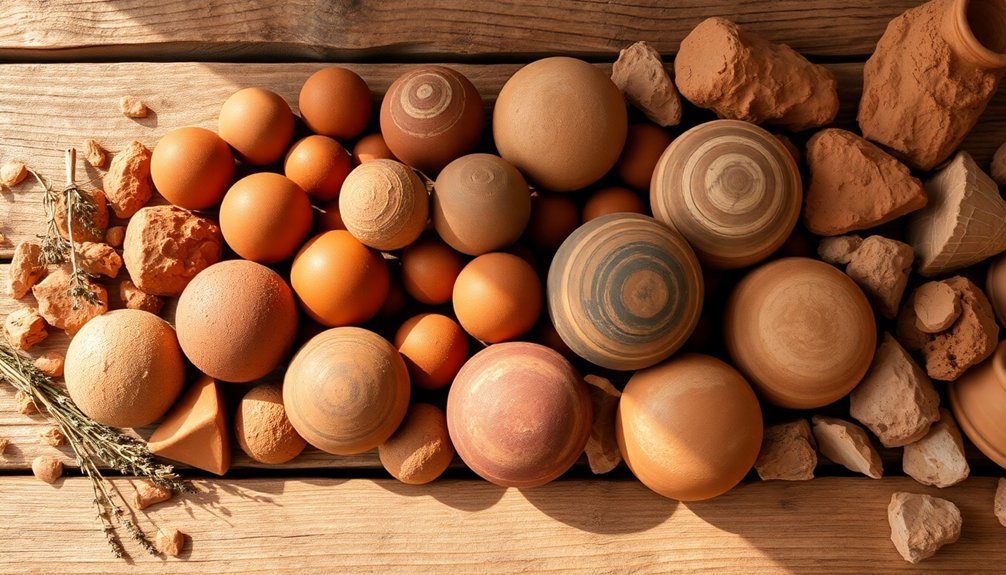
While modern soapmakers often turn to synthetic ingredients, the practice of incorporating clay into soap originated thousands of years ago in ancient civilizations.
You'll find that traditional methods evolved distinctly across regions, with artisans developing unique approaches based on their local clay deposits and mineral compositions.
The ancient Egyptians pioneered these techniques, recognizing clay's therapeutic properties in both medicine and cosmetics. Their artisanal craftsmanship laid the foundation for utilizing natural colors and healing properties found in varieties like kaolin and illite.
These clays provided gentle exfoliation while absorbing excess oils from the skin.
Today's artisans continue to honor these time-tested soapmaking traditions, combining historical knowledge with contemporary techniques.
They're preserving the authentic methods that have proven effective for centuries, creating products that celebrate clay's enduring role in natural skincare.
Understanding Natural Clay Properties and Characteristics
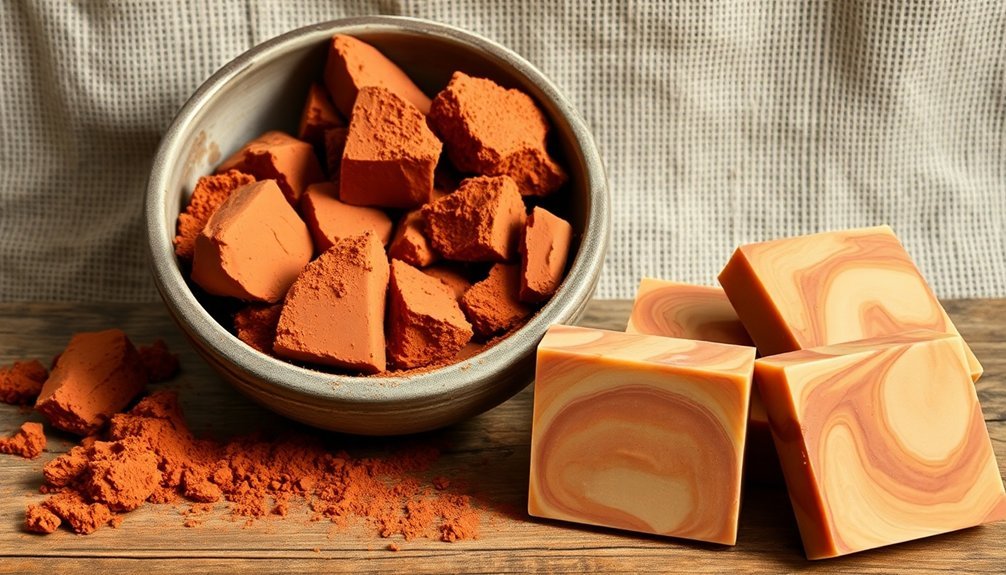
When you're working with natural clays in soap making, you'll find their exceptional absorption capabilities stem from unique mineral compositions that actively draw impurities from your skin.
Your choice of clay matters greatly, as each type offers distinct mineral content – from bentonite's powerful oil-absorbing properties to French green clay's rich mineral profile for detoxification.
These clays transform when wet, creating smooth, workable surfaces that enhance your soap's texture while maintaining their beneficial properties throughout the curing process.
Clay Absorption And Detoxification
Natural clays stand as powerful allies in skincare, offering remarkable absorption and detoxification properties that have been prized for centuries.
You'll find that different clay varieties, such as bentonite and French green clay, excel at drawing out excess oils and impurities from your skin, promoting a clearer complexion.
When you're choosing clay for skincare formulations, consider that kaolin works gently on sensitive skin, while rhassoul provides additional exfoliating benefits.
The natural porosity of these clays enables them to trap and remove toxins, pollutants, and unwanted substances from your pores.
This clay absorption process helps prevent acne and reduces skin blemishes effectively.
Whether you're crafting soaps or facial masks, you'll discover that incorporating natural clays enhances both the therapeutic value and aesthetic appeal of your skincare products.
Earth-Based Mineral Content
The rich mineral composition of clays determines both their distinctive colors and therapeutic properties. When you're exploring earth-based clays for soapmaking, you'll notice how their natural ingredients reveal their mineral content. Iron oxide creates warm red tones, while magnesium produces verdant green hues.
You'll find that geographic origin plays a significant role in clay's detoxifying qualities. French green clay, formed from volcanic activity, contains concentrated minerals that make it particularly effective for deep cleansing.
Kaolin's gentle nature comes from its low mineral content, making it perfect for sensitive skin applications. If you're working with smectite clays, you'll need to carefully balance their high mineral absorption rates to prevent cracking in your soaps.
Each clay's unique mineral profile contributes specific benefits to your artisanal soap creations.
Surface Properties When Wet
Understanding how clay behaves when moisture is introduced will transform your soap-making process. When you work with wet clay in your artisan soap creations, you'll notice its enhanced plasticity, making it easier to mold and shape unique designs.
The surface properties change dramatically as moisture interacts with the material, creating a reflective quality that reveals the clay's true colors and mineral composition.
You'll find that wet clay's absorbent nature plays a crucial role in the saponification process, maintaining consistent moisture levels for ideal chemical reactions. This characteristic also contributes to your soap's final texture and cleansing abilities.
As you incorporate clay into your formulations, you'll achieve smoother application and enhanced impurity-drawing properties. These wet properties are essential for creating the perfect balance of aesthetics and functionality in your finished soap.
Essential Clay Types for Artisanal Soap Creation
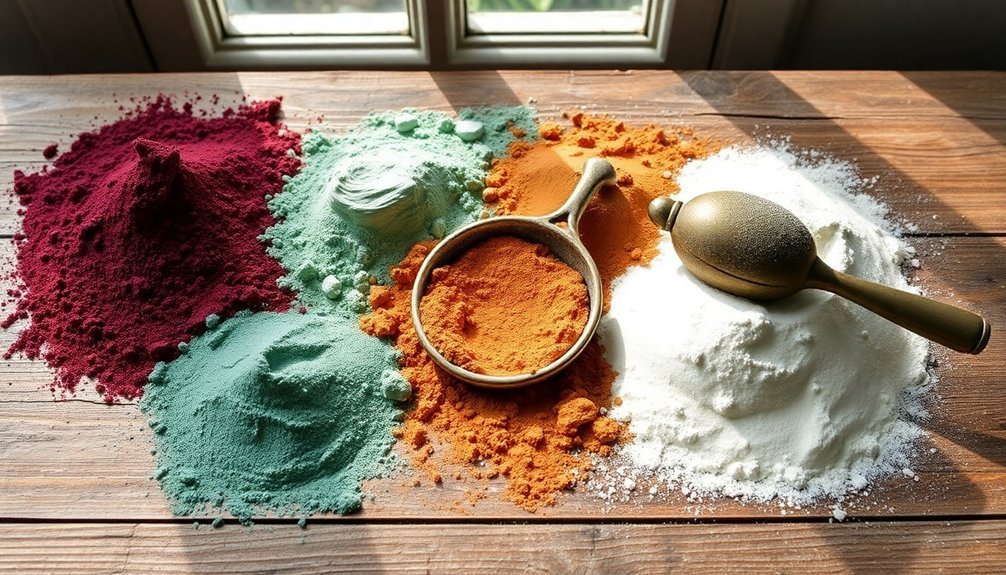
Clay selection serves as a cornerstone of artisanal soap making, offering both aesthetic appeal and therapeutic benefits.
The thoughtful selection of clay elevates handcrafted soaps from simple cleansers to therapeutic skincare treatments worth treasuring.
You'll find that each clay type brings unique properties to your soap formulations, from gentle cleansing to deep detoxification.
- When you're working with sensitive skin formulations, Kaolin clay's mild nature makes it your safest choice, while bentonite clay excels at drawing out excess oils.
- For deep cleansing properties, French green clay's mineral-rich composition delivers powerful detoxifying results.
- Rhassoul clay enhances your soap's texture with gentle exfoliation, leaving skin remarkably smooth.
- To add natural color variations, you can incorporate Moroccan red clay for warm tones or French pink clay for delicate rosy hues.
These ancient ingredients not only enhance your soap's visual appeal but also provide targeted skincare benefits that modern artisans continue to value.
Traditional Clay Preparation Methods
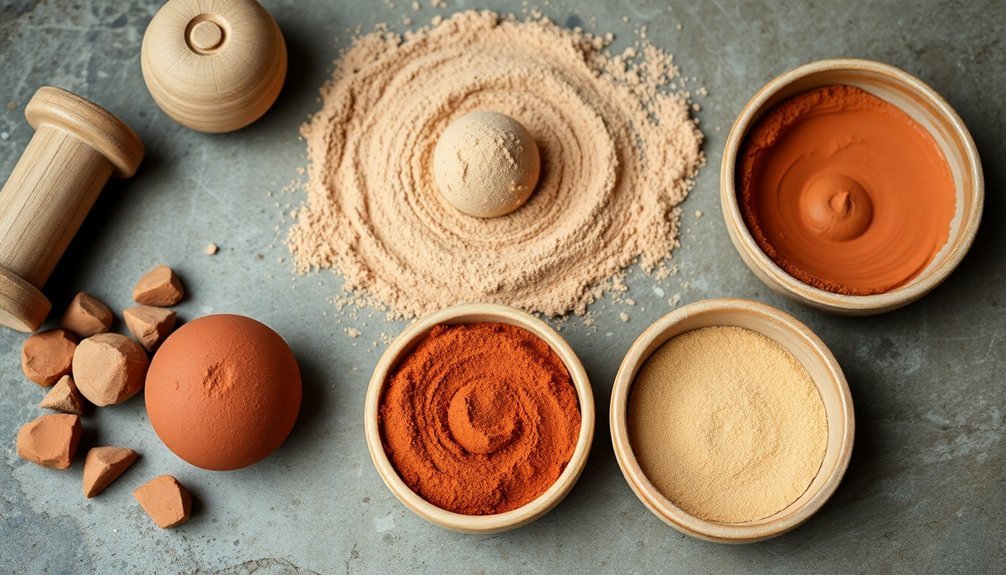
You'll find ancient clay preparation begins with carefully soaking raw earth materials in clean water, allowing natural sediments to settle while impurities float to the surface.
Once settled, you're ready to strain and dry the clay before grinding it into fine powder using traditional stone mortars or wooden mallets.
Your hand-ground clay powder must then pass through fine mesh screens to guarantee uniform texture before it's ready for soap making.
Clay Soaking Ancient Methods
When preparing clay for artisan soap making, ancient cultures developed sophisticated soaking techniques that continue to influence modern methods.
You'll find that traditional methods focused on achieving the perfect texture and consistency for high-quality results.
Here are the time-tested clay soaking approaches that have proven most effective:
- Water immersion – The classic technique of submerging clay for extended periods to enhance pliability
- Atole method – Using corn-based drinks to infuse clay with unique properties while curing
- Lime cure treatment – Mixing lime and water to create a strengthening paste that improves durability
- Milk soaking – A specialized process that neutralizes unwanted odors for pure artisan soaps
These methods demonstrate how ancient wisdom continues to shape modern clay preparation, ensuring ideal results in contemporary soap making.
Hand-Ground Earth Powders
Traditional grinding practices stand at the heart of artisan soap making, where natural clays are carefully crushed and sifted into fine, vibrant powders.
When you're working with hand-ground earth powders, you'll discover that each clay type offers unique properties and distinct hues that enhance your soap's aesthetic appeal and functionality.
You'll find that traditional methods of preparing local clays involve sun-drying and meticulous sieving to guarantee the highest quality powder for your soap formulations.
By choosing these eco-friendly preparation techniques, you're preserving the natural minerals and qualities inherent in the clay.
Whether you're using kaolin, illite, or smectite, these hand-ground powders connect your craft to centuries of soap-making tradition while reflecting the rich geological diversity of your region.
Color Extraction and Enhancement Techniques
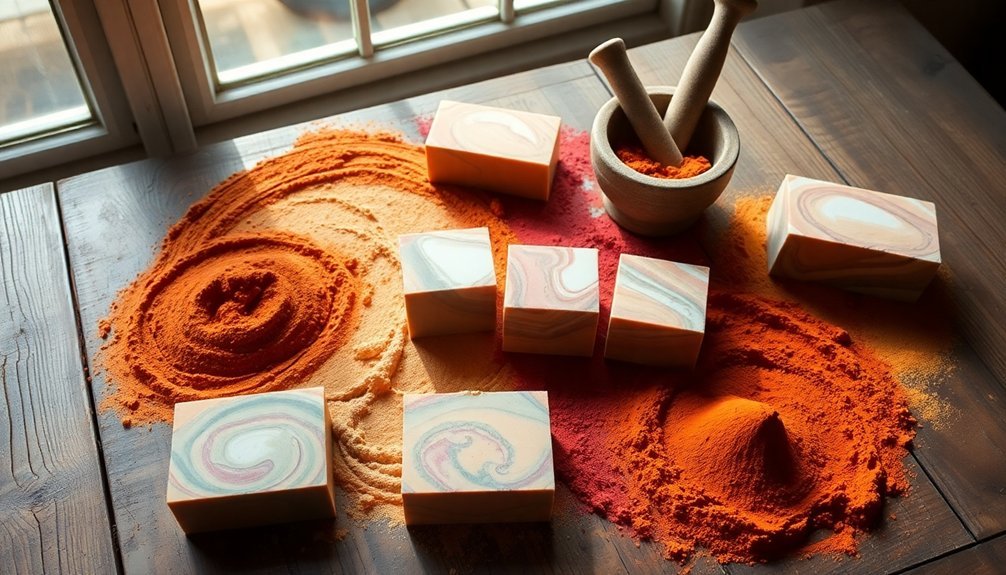
The art of extracting vibrant colors from natural clays demands both precision and understanding of their mineral compositions.
You'll find that different clay varieties, from Moroccan red to French green, offer unique hues based on their geographical origins. To enhance these natural colorants in your artisan soap, you'll need to master specific enhancement techniques.
- Pre-mix your clay with distilled water to achieve smoother consistency and prevent clumping.
- Blend clay with oils or glycerin for better dispersion and more vibrant results.
- Experiment with clay-to-soap ratios to control color intensity.
- Combine clays with powdered herbs for intricate color variations.
These methods guarantee superior color extraction while maintaining the clay's beneficial properties.
You'll discover that proper preparation and mixing techniques are essential for creating visually stunning soaps with consistent, streak-free colors.
Blending Clay Colors for Unique Soap Designs
You'll discover remarkable marble effects by carefully swirling French green clay with Moroccan red clay in your soap batter, creating distinctive patterns that echo ancient pottery designs.
To achieve smooth color shifts, you can pre-mix your chosen clays with distilled water before introducing them to your soap mixture, preventing unwanted clumping and ensuring even distribution.
Your layering technique will benefit from understanding each clay's natural color palette, from kaolin's soft beige to the rich brown tones of Moroccan clay, allowing you to craft intentional color combinations.
Marble Swirl Clay Techniques
Creating stunning marble swirl effects with clay-infused soaps requires mastering a delicate balance of timing and technique.
You'll achieve the best results by pre-mixing your clay with distilled water at a 3:1 ratio, ensuring a smooth consistency that blends seamlessly into your soap batter.
- Separate your emulsified soap batter into portions and mix in different types of clay, such as French green and Moroccan red, to create distinct color variations.
- Pour your colored batters carefully into your mold, maintaining clear color separation.
- Use spatulas or skewers to create unique textures and visual effects without overmixing.
- Experiment with different clay combinations in soap making to develop one-of-a-kind marble patterns.
The key to successful marble swirl clay techniques lies in careful color manipulation and precise pouring methods, making each batch a unique artistic expression.
Natural Color Layering Effects
While mastering natural color layering might seem challenging at first, blending different clay colors offers endless possibilities for creating distinctive soap designs. You'll discover that pre-mixing clays with distilled water helps achieve smooth dispersion in your handmade soaps, preventing unwanted clumping and ensuring even distribution.
| Clay Type | Color Effect | Unique Benefits |
|---|---|---|
| French Green | Sage to Forest | Detoxifying |
| Pink Clay | Soft Rose | Gentle Exfoliation |
| Kaolin | Creamy White | Sensitive Skin Care |
| Bentonite | Light Gray | Deep Cleansing |
When you're working with clay colors, experiment with different combinations to create stunning gradients and marbled effects. Each clay brings its own skin benefits to your soap, so you're not just crafting beautiful designs – you're also enhancing the therapeutic properties of your handmade creations.
Cultural Significance of Clay Colors in Soap Making
Throughout history, colored clays in soap making have represented far more than mere aesthetic choices. These natural resources carry deep cultural heritage, reflecting the unique geological makeup of regions like Morocco and France, where traditional artisan practices continue to thrive.
Ancient artisans viewed colored clays as sacred gifts from the earth, transforming humble minerals into cultural expressions through soap making.
You'll discover that these vibrant earth pigments connect communities to their ancestral wisdom through:
- Traditional healing properties passed down through generations, linking personal care to cultural wellness beliefs
- Community identity expressed through shared soap-making rituals and knowledge transmission
- Local geological treasures that showcase each region's distinctive mineral compositions
- Ancient cultural practices preserved through colors like Aleppo's green clay, which maintains historical significance
When you work with these colored clays, you're not just creating soap – you're participating in a tradition that spans centuries and connects cultures through their relationship with the earth.
Best Practices for Clay Integration in Cold Process Soap
Successful clay integration in cold process soap requires careful preparation and timing.
When crafting your handmade soap, you'll want to mix your clay with distilled water in a 1:3 ratio to prevent clumping and guarantee smooth distribution throughout your natural oils.
For single-color cold process soaps, add clay directly to your lye solution for consistent coloring. If you're creating marbled effects, separate your soap batter after emulsification and pre-mix clay with water before adding it to different portions.
Consider different clay types based on your target skin types – bentonite offers deep cleansing while kaolin provides gentle exfoliation.
Don't forget to insulate or oven process your soap to achieve complete gel phase, which enhances both color intensity and texture.
This step is essential for maximizing the visual appeal and therapeutic benefits of your clay-infused creations.
Achieving Color Stability With Natural Clay Pigments
Beyond mastering the basic clay integration techniques, achieving lasting color stability with natural clay pigments requires specific attention to preparation and processing methods.
You'll find that proper handling of clays in your handmade soap guarantees both beautiful and enduring results.
- Pre-mix your clay with water to prevent clumping and achieve even distribution throughout your cold-process soap.
- Consider adding clay directly to your lye solution to enhance color vibrancy through chemical bonding.
- Select clays based on their oil-pulling properties, which affect both color intensity and final texture.
- Store your finished soaps in cool, dry conditions to maintain color integrity.
Artisanal Clay Soap Curing and Storage Methods
A well-executed curing and storage process forms the foundation of quality clay soap production. Your artisanal clay soaps need 4-6 weeks of curing in a cool, dry environment to develop their ideal hardness and longevity. During this natural aging process, you'll want to rotate your soaps regularly for even air circulation.
| Stage | Action | Duration |
|---|---|---|
| Initial Cure | Place in cool area | Week 1-2 |
| Mid Cure | Rotate bars weekly | Week 3-4 |
| Final Cure | Check hardness | Week 5-6 |
| Pre-Storage | Wrap in muslin/paper | After cure |
| Long-term | Monitor for moisture | Ongoing |
For proper storage methods, wrap your cured clay soaps in breathable materials like muslin or parchment paper. Keep them away from direct sunlight and inspect regularly for any signs of moisture or mold to maintain their artisanal quality.
Modern Applications of Ancient Clay Techniques
While ancient civilizations pioneered the use of clay in soap making, today's artisans have revolutionized these time-tested techniques for modern production.
You'll find that ancient clay techniques have been seamlessly integrated into contemporary skincare products, offering both aesthetic appeal and therapeutic benefits.
Modern artisan soap makers embrace natural ingredients through these innovative approaches:
- Incorporating Moroccan red and French green clays into cold process soap for rich, natural coloring
- Mixing clay directly into lye solutions to create unique textures and exfoliating properties
- Using traditional clay ratios to enhance the soap's mineral content and skin benefits
- Crafting eco-friendly products that honor historical clay applications while meeting modern sustainability standards
These methods showcase how ancient wisdom continues to influence today's natural skincare movement, providing customers with authentic, chemical-free alternatives.
Frequently Asked Questions
Is Clay Soap Good for Your Skin?
Yes, clay soap's great for your skin! You'll benefit from its gentle exfoliation, oil-absorbing properties, and deep cleansing abilities. It won't strip your skin's moisture while helping to draw out impurities and toxins.
What Does Adding Clay to Soap Do?
When you add clay to soap, you'll get natural coloring, gentle exfoliation, and improved lather. It helps draw out skin impurities, enhances essential oil retention, and creates a creamier texture for your skincare routine.
How Much Bentonite Clay to Add to Soap?
You'll want to add 1-2 teaspoons of Bentonite clay per pound of oils in your soap recipe. Mix it with water first to prevent clumping and guarantee even distribution throughout your batch.
What Are the Traditional Soap Making Techniques?
You'll find traditional soap making relies on cold process methods, where you combine oils with lye solution, letting saponification occur naturally. Hand-cutting, natural colorants, and small-batch production preserve ancestral techniques.
In Summary
When you're ready to explore clay-based soapmaking, you'll discover it's a journey connecting you to ancient artisans. Whether you're using French green clay, Moroccan red clay, or Brazilian purple clay, you've got centuries of wisdom at your fingertips. Start with small batches, document your results, and don't be afraid to experiment. You're not just making soap – you're preserving a timeless craft.

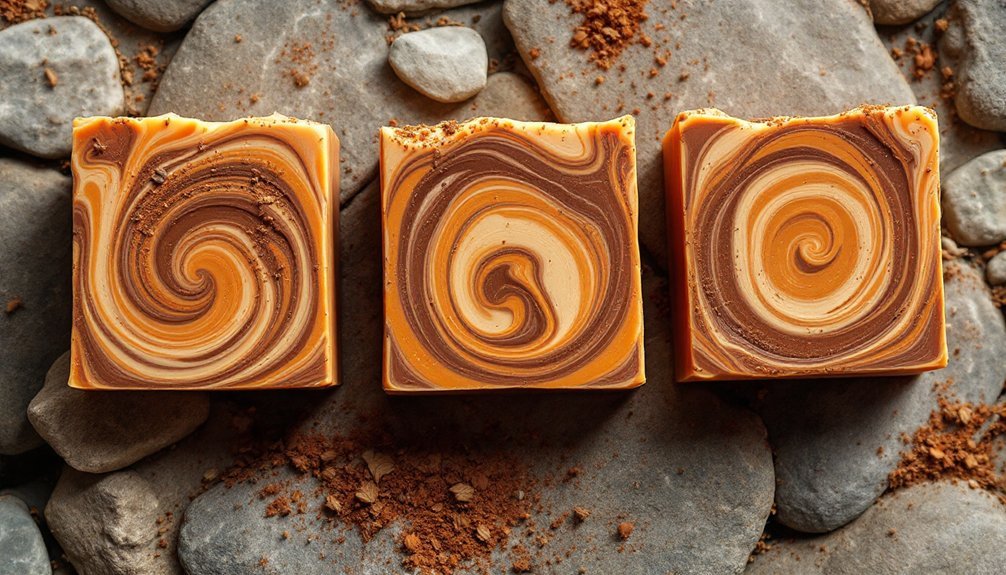



Leave a Reply